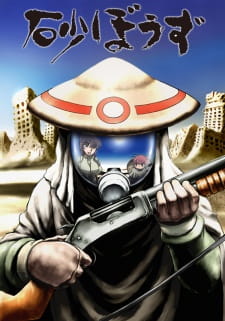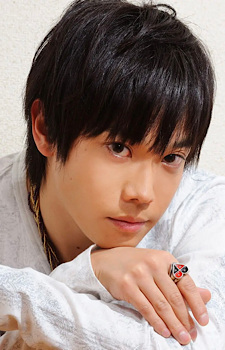
Sunabouzu
Summary: The Great Kanto Desert, a sweltering wasteland of nothing but ruins and sand, is all that remains of post-apocalyptic Japan. The once fair population has been left to cling to the inhospitable dunes for survival. At least, that is the case for normal people. For those who have spent a little too long in the Kanto sun, the desert offers a wondrous opportunity to make a name for themselves.
One such person is the masked handyman "Sunabouzu," or Desert Punk, who has forged a legendary reputation for always finishing his jobs, no matter the nature or cost. Cunning and ruthless, he has become a force of crude destruction to the other desert people. However, the "Vixen of the Desert," Junko Asagiri, discovers that Sunabouzu is not without his weaknesses—he is easily swayed by his insatiable lust for large-breasted desert babes.
Following their chaotic adventures through the Kanto Desert, Sunabouzu features a bizarre cast of personalities who entertain themselves with senseless violence and perversion in a world long destroyed by their forefathers. And just like them, they have not learned a damn thing.
[Written by MAL Rewrite]
Description
The Great Kanto Desert, a sweltering wasteland of nothing but ruins and sand, is all that remains of post-apocalyptic Japan. The once fair population has been left to cling to the inhospitable dunes for survival. At least, that is the case for normal people. For those who have spent a little too long in the Kanto sun, the desert offers a wondrous opportunity to make a name for themselves.
One such person is the masked handyman "Sunabouzu," or Desert Punk, who has forged a legendary reputation for always finishing his jobs, no matter the nature or cost. Cunning and ruthless, he has become a force of crude destruction to the other desert people. However, the "Vixen of the Desert," Junko Asagiri, discovers that Sunabouzu is not without his weaknesses—he is easily swayed by his insatiable lust for large-breasted desert babes.
Following their chaotic adventures through the Kanto Desert, Sunabouzu features a bizarre cast of personalities who entertain themselves with senseless violence and perversion in a world long destroyed by their forefathers. And just like them, they have not learned a damn thing.
[Written by MAL Rewrite]
Available At
Warning: Array to string conversion in /home/hianime.me.uk/public_html/anime.php on line 243
Array
Sunabouzu Trailers
Sunabouzu Pictures
Sunabouzu Review
Sunabouzu — The Great Kanto Desert, a sweltering wasteland of nothing but ruins and sand, is all that remains of post-apocalyptic Japan. This overview is intentionally spoiler-free and focuses on tone and intent rather than plot specifics.
Thematically, It sits firmly within Action, Adventure, Comedy, Sci-Fi, Ecchi conventions as a TV work and has garnered attention (MAL score: 7.36). This work explores character dynamics, tonal shifts, and the interplay between narrative ambition and execution. The story's pacing and tonal choices are crafted to complement the central ideas, often emphasizing atmosphere and emotional truth over explicit exposition. The show's ability to evoke a consistent mood — whether melancholic, exuberant, or contemplative — is a recurring strength, and the scenes are constructed so viewers can infer stakes without needing explicit spoilers.
Characterization is a core pillar here. Protagonists and supporting figures are written with distinct motivations and narrative roles; even when archetypal, the series invests in small behavioral details that make choices feel earned. Character arcs are handled with an eye for gradualism: development often arrives through incremental beats rather than abrupt, expository shifts. The interactions between characters create texture, and relationships are used to illuminate both personal flaws and larger thematic concerns.
On the visual front, production values play a significant role. The animation quality varies by sequence but frequently showcases thoughtful direction and composition. Background art, framing, and color palettes are used deliberately to support tone — quieter scenes favor muted palettes while action or heightened emotional beats employ brighter, more kinetic visuals. Direction choices, such as camera movement and shot selection, often elevate scenes beyond their raw script, creating moments that linger in the viewer's mind.
The soundscape — score, incidental music, and sound design — complements the visual language. Music cues are placed to maximize emotional resonance without manipulating the audience with melodrama; this restraint often leads to more authentic emotional payoff. Sound design punctuates key moments, and when the series leans on silence, those quieter moments are given weight by measured audio choices.
Pacing and structure are handled with craft. Episodes are arranged to build tension and release methodically, and the narrative rarely rushes through important emotional beats. That said, the deliberate pacing may feel slow to viewers who prefer faster plot turnover; the reward is greater nuance and an accumulation of meaning across the series. Accessibility is generally good — one can appreciate surface-level pleasures, while repeat or attentive viewing reveals additional layers.
No title is without flaws. Occasional unevenness in subplots or variable animation across episodes can be distracting. Some tonal shifts might feel abrupt if you expect uniformity; others will argue that those shifts are purposeful. These are worth noting, but they seldom undercut the larger achievements of the work.
In sum, Sunabouzu offers a rich experience for viewers who value character-driven storytelling, considered visual design, and a soundtrack that supports rather than overwhelms. For fans of Action, Adventure, Comedy, Sci-Fi, Ecchi, this is an especially rewarding watch. It's recommended for those who appreciate layered narratives and artistry in animation, and best approached with patience and attention to nuance.
Characters & Voice Actors

Asagiri, Junko
Main

Asagiri, Junko
Main

Asagiri, Junko
Main

Asagiri, Junko
Main

Asagiri, Junko
Main

Koizumi, Taiko
Main

Koizumi, Taiko
Main

Koizumi, Taiko
Main

Koizumi, Taiko
Main

Koizumi, Taiko
Main

Mizuno, Kanta
Main

Mizuno, Kanta
Main

Mizuno, Kanta
Main

Mizuno, Kanta
Main

Mizuno, Kanta
Main

Amagumo
Supporting

Amagumo
Supporting

Amagumo
Supporting

Asari
Supporting

Asari
Supporting
Staff

Cook, Justin
Producer

Kojima, Tsutomu
Producer

Watanabe, Takashi
Producer

Watson, Barry
Producer

Inagaki, Takayuki
Director, Episode Director, Storyboard, Key Animation

Motoyama, Satoshi
Sound Director

Awai, Shigeki
Episode Director

Itagaki, Shin
Episode Director, Storyboard, Key Animation, Assistant Director

Karato, Mitsuhiro
Episode Director

Kumagai, Masaaki
Episode Director

Mizumoto, Hazuki
Episode Director

Sasaki, Masaya
Episode Director

Yasukawa, Masaru
Episode Director

Nakamura, Koujirou
Script

Takeda, Yuuichirou
Script

Vale, Eric
Script

Kamijou, Osamu
Storyboard, Key Animation

Matsushita, Yukihiro
Storyboard

Nemuro, Dai
Storyboard

Jewell, Jerry
Theme Song Performance